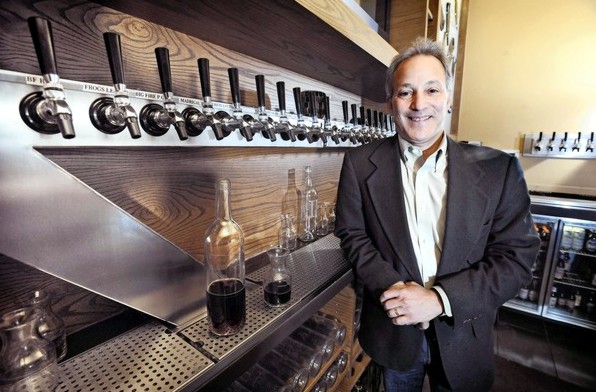Having A Kegger . . .With Cabernet . . . by Joel Mann, Staff Wine (And Beer) Tasting Guy

Packaging decisions are one of the major issues that wineries and winemakers deal with in their business planning cycles. Choosing bottles, getting labels approved, deciding what type of cork to use, or even going with a twist-top closure are all factors that must be weighed and considered. Packing choices have evolved over time as well. Winemakers can forgo bottles for bag-in-a-box casks, can go with specialty cardboard boxes called tetra paks similar to milk and juice containers, or even decide to package their wine in cans such as Sophia from Coppola. One packaging format seeing a revival as wineries compete more in the on-premise world of restaurants is kegged wine. This month, I want to examine the foray of the wine world into the realm once reserved for brewers – the draught keg, and see why it’s a good choice for the wine industry.
One of the primary advantages that beer holds as a common beverage of choice is that restaurants and entertainment venues can readily poor single servings of fresh beer to a large number customers courtesy of large kegs. Wineries tried the concept, but the market demand never really seemed to match the product supply. Part of the reason was a common conception that good wine was only served from a bottle, and you either ordered a full bottle at a nice restaurant for premium options, or had a glass poured from a bottle for the more modestly priced house selections. As a result, wine was simply not a regular choice given the cost of full bottles, or quality issues in bottles sitting open for the selections served by the glass. As the tastes of younger entertainment goers evolved though, the demand for quality wine has increased in dining and entertainment, spurred on by the foodie revolution that occurred over the last 10-20 years.
Many bars and restaurants are now establishing dedicated wine taps to provide a larger selection of premium wine choices in the by-the-glass format, utilizing the draught keg option to satisfy the increased demand. Flexibility from technology has helped drive the market as well. Younger customers have come to accept that the form of packaging is not their concern when ordering a glass of wine, so long as the quality of the wine is maintained as it’s poured into their glass.
Kegs offer a number of advantages when it comes to serving a volume quantity over other packaging options. First, kegs are easily cleaned and sanitized, preserving wine quality. The stainless steel can be washed, rinsed, steamed, and cooled just like the tanks used in wine production. The process can be performed in a very short time period as well with automated kegging equipment. The weight to volume ratio favors the wine, making kegs one of the most efficient ways to transport product versus other packaging formats. Kegs are easily reusable, whereas bottles are not. Kegs are sealed, and dispense their volume through compressed gas.
So long as the tapping system utilizes nitrogen or a nitrogen/carbon dioxide mix from a canister, there is essentially zero chance of oxidation (wine taps don’t use straight CO2 like beer, as it would make the wine spritzy). Kegs also occupy less space for a given volume of wine than other packaging formats, making them the ideal packaging for large volume service.
An ever increasing number of bars and restaurants are driving the demand for kegged wine, and a number of wineries are jumping on the bandwagon. Premium wine-by-the-glass choices with price ranges from $5-$10 are now a common option at many establishments, including several of the most popular commercial brands and varieties. A number of service businesses are making it a far easier options as well.
Kegging operations utilize a portable tank system that’s typically 525 gallons (equivalent to about 220 cases of wine in standard bottles). Wineries fill the tank, which gets transported to a kegging facility, who then stores and ships the final product to distributors and direct service accounts. The 5.16 gallon torpedo keg is the industry standard. One portable tank of wine yields around 100 torpedo kegs. Each keg results in roughly 165 standard wine servings for enjoyment in a bar or restaurant.
The keg option allows for better quality and greater variety in entertainment and dining beverage choices, which is a win for consumers. So with due respect to the brew masters out there, why not tap a keg of wine next time instead.
Drink responsibly.





